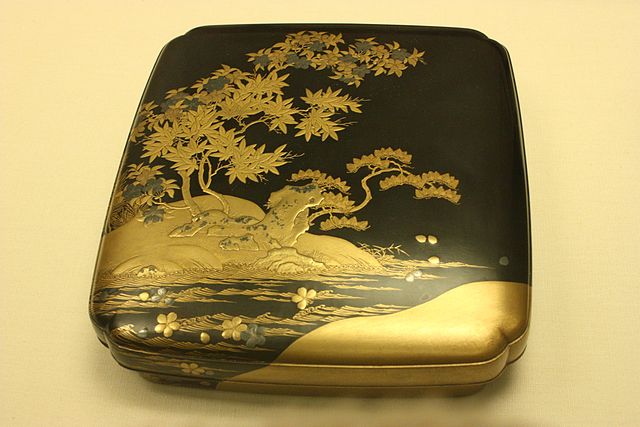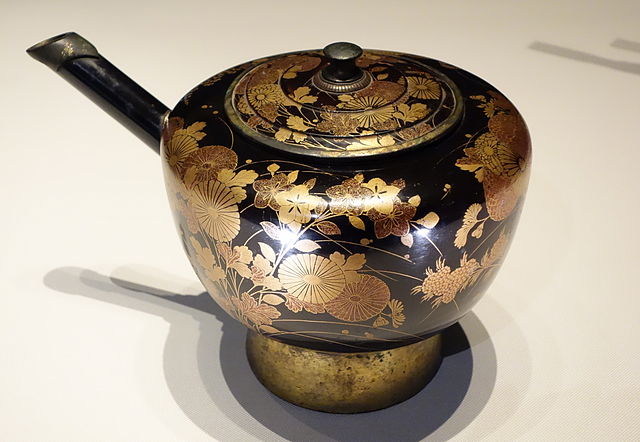One of the most beautiful Japanese handicrafts – in my opinion at least – is lacquerware, also called shikki or urushi. Like maný things Japanese, lacquerware originally came from China, but once again, the Japanese have refined the techniques and raised them to new heights.
 Lacquer is the filtered sap of the urushi tree, and as the midsummer sap is of the best quality, the tree is usually tapped between June and October, in a similar way as rubber or maple syrup is gathered: by making cuts into the tree’s bark at different places. A sign of quality is the amount of urushic acid in the sap (80 – 85 % is optimal), and the sap from different trees should be kept apart. Interestingly, liquid lacquer is very toxic and needs to be handled with care and safety clothing, but once hardened it is practically insoluble, and drinking from a lacquered cup for example is harmless.
Lacquer is the filtered sap of the urushi tree, and as the midsummer sap is of the best quality, the tree is usually tapped between June and October, in a similar way as rubber or maple syrup is gathered: by making cuts into the tree’s bark at different places. A sign of quality is the amount of urushic acid in the sap (80 – 85 % is optimal), and the sap from different trees should be kept apart. Interestingly, liquid lacquer is very toxic and needs to be handled with care and safety clothing, but once hardened it is practically insoluble, and drinking from a lacquered cup for example is harmless.
 Producing a lacquered object is relatively easy: A thick layer of lacquer is applied, left to dry – lacquer dries best in a somewhat damp environment between 20 and 26 degrees – and then polished. This process is repeated numerous times until the desired thickness of the lacquer has been reached; different types of lacquer require different periods of drying (from two days to one month), and different means of polishing (from simple whetstones to deerhorn powder). The complicated parts are the preparation of the object to be lacquered – the core – and the final ornamentations that may be applied at the end.
Producing a lacquered object is relatively easy: A thick layer of lacquer is applied, left to dry – lacquer dries best in a somewhat damp environment between 20 and 26 degrees – and then polished. This process is repeated numerous times until the desired thickness of the lacquer has been reached; different types of lacquer require different periods of drying (from two days to one month), and different means of polishing (from simple whetstones to deerhorn powder). The complicated parts are the preparation of the object to be lacquered – the core – and the final ornamentations that may be applied at the end.
 In principle, any material can be lacquered – metal, porcelain, ivory, etc., I once even saw a lacquered leaf – but the core of most lacquer work is wood. Clearly, the size of the object determines the type of wood that lies underneath, but for small, everyday things like bowls or boxes, a core made of cypress wood is most commonly used. When the core has been made, a single layer of lacquer is applied. After drying, channels and joints of the core are carefully covered with a mixture of lacquer, hemp, and rice starch, and then the piece is dried again. This layer is rubbed down to give a smooth surface, then another one of sabi, a mixture of lacquer and burnt clay, is applied. When this is dry, the piece is covered with cloth (hemp or linen) to prevent the wood from cracking. Again, several layers of sabi are applied on top of the cloth, dried and polished each time. Only after this procedure is finished, the “true” lacquering as described above will start.
In principle, any material can be lacquered – metal, porcelain, ivory, etc., I once even saw a lacquered leaf – but the core of most lacquer work is wood. Clearly, the size of the object determines the type of wood that lies underneath, but for small, everyday things like bowls or boxes, a core made of cypress wood is most commonly used. When the core has been made, a single layer of lacquer is applied. After drying, channels and joints of the core are carefully covered with a mixture of lacquer, hemp, and rice starch, and then the piece is dried again. This layer is rubbed down to give a smooth surface, then another one of sabi, a mixture of lacquer and burnt clay, is applied. When this is dry, the piece is covered with cloth (hemp or linen) to prevent the wood from cracking. Again, several layers of sabi are applied on top of the cloth, dried and polished each time. Only after this procedure is finished, the “true” lacquering as described above will start.
 Natural lacquer is transparent, but often coloured pigments are added, for example India ink or – traditionally – iron filings boiled with vinegar give black, silicate powder gives white, vermillion red, metallic powders give gold, silver, or copper tones. Coloured lacquer is used in lacquer carvings, for example. Numerous layers of – sometimes differently coloured – lacquer are applied to the core, and then an image is carved into the lacquer, showing the different colours.
Natural lacquer is transparent, but often coloured pigments are added, for example India ink or – traditionally – iron filings boiled with vinegar give black, silicate powder gives white, vermillion red, metallic powders give gold, silver, or copper tones. Coloured lacquer is used in lacquer carvings, for example. Numerous layers of – sometimes differently coloured – lacquer are applied to the core, and then an image is carved into the lacquer, showing the different colours.
 Metal powder is also used in Maki-e, a kind of painting lacquer ornamentations, that has been developed in the Nara period (645 – 794). Essentially, a design is painted with lacquer onto the piece. The wet lacquer is then dusted or rubbed with coloured powder, and so, layer by layer, the final image is created. When the design is complete, a final layer of clear lacquer is applied to even out the surface, which is then polished.
Metal powder is also used in Maki-e, a kind of painting lacquer ornamentations, that has been developed in the Nara period (645 – 794). Essentially, a design is painted with lacquer onto the piece. The wet lacquer is then dusted or rubbed with coloured powder, and so, layer by layer, the final image is created. When the design is complete, a final layer of clear lacquer is applied to even out the surface, which is then polished.
 Lacquerware remains an expensive artwork that takes a long time to create. Even if some steps can be automated with the help of machines (making the wooden core for example), the final decorations lie still in the hands of an artist.
Lacquerware remains an expensive artwork that takes a long time to create. Even if some steps can be automated with the help of machines (making the wooden core for example), the final decorations lie still in the hands of an artist.

